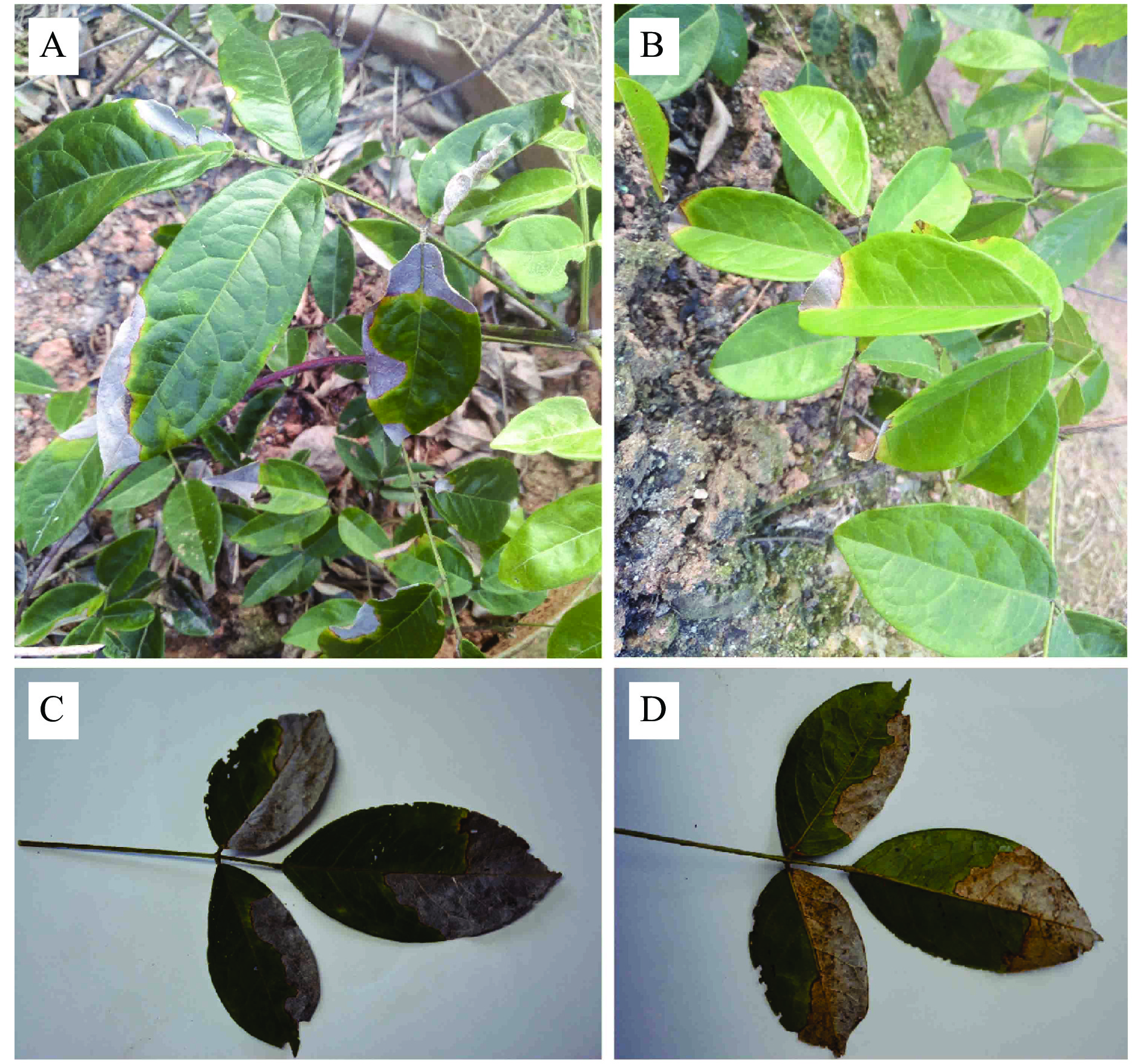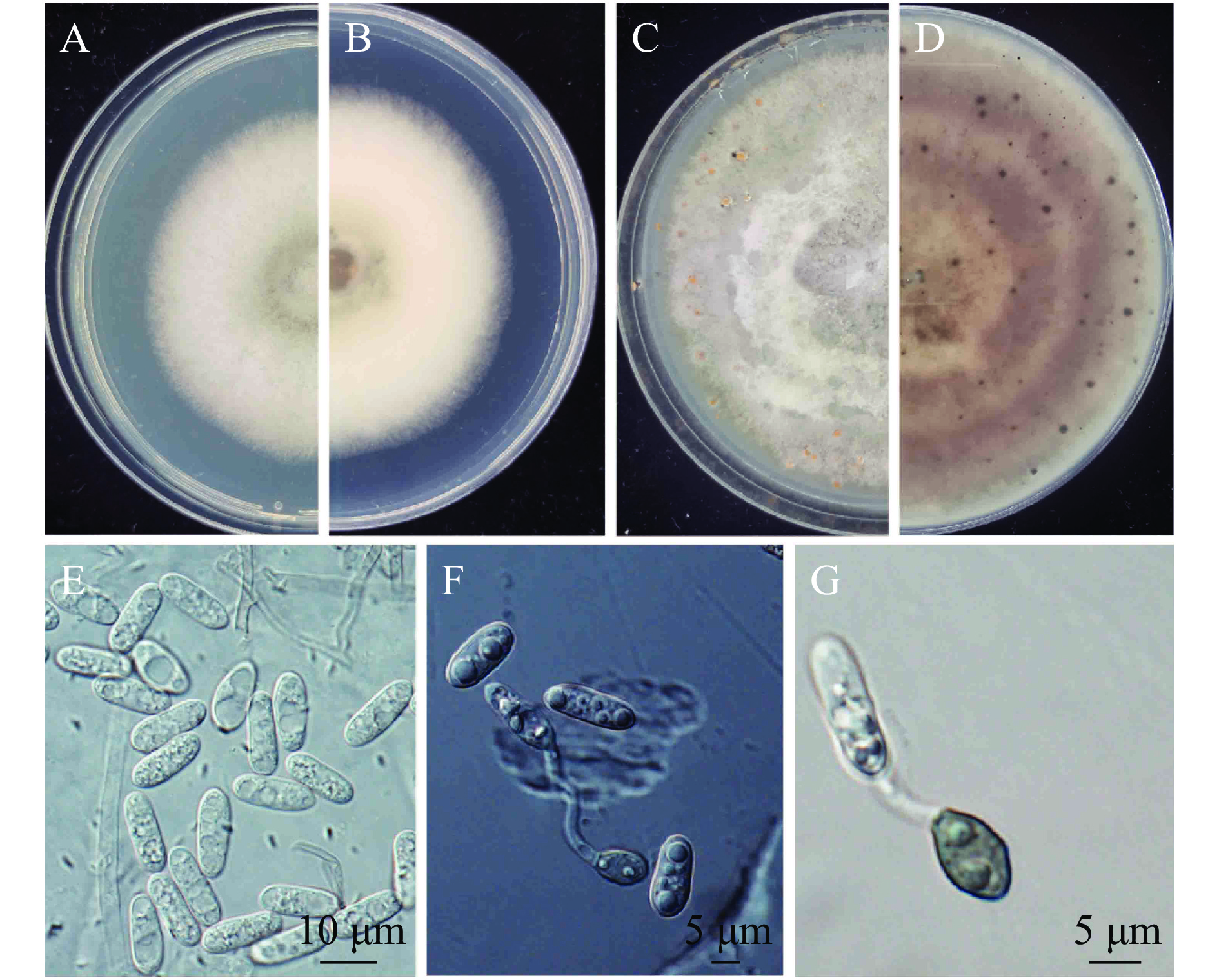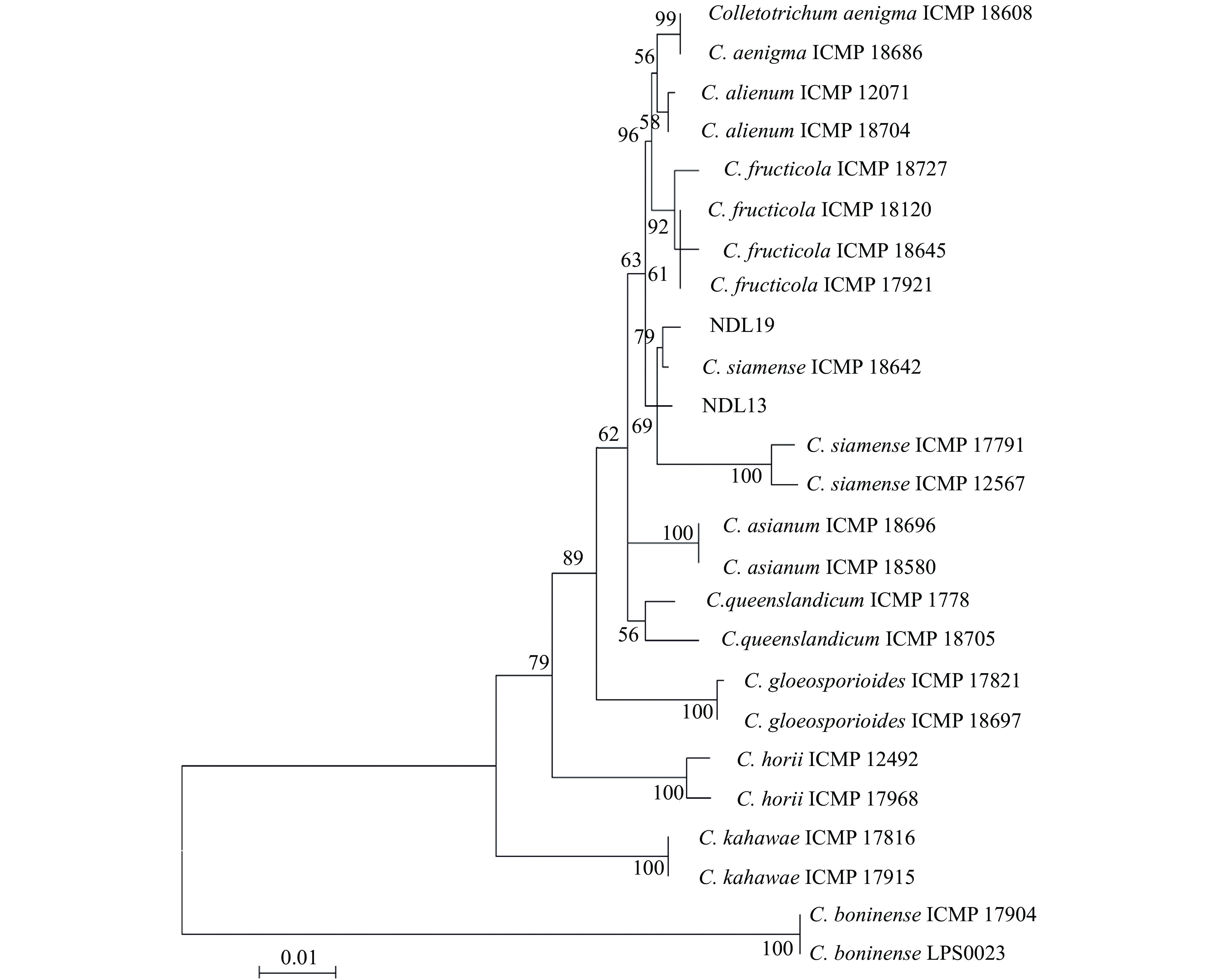Pathogen identification of anthracnose disease on Millettia speciosa and indoor determination of fungicide toxicity
-
摘要:目的
明确引起美丽崖豆藤炭疽病的病原菌种类并筛选其防治药剂。
方法采用组织分离法对病原菌进行分离、纯化后,利用柯赫氏法则验证其致病性,依据菌株的形态学特征和多基因序列分析确定病原菌种类;采用菌丝生长速率法测定病原菌对生产上常用于炭疽病防治的4种杀菌剂的敏感性。
结果分离得到的6株菌中有2株菌可侵染美丽崖豆藤叶片引起褐色病斑;结合形态学鉴定和多基因序列分析,确定引起美丽崖豆藤炭疽病的病原菌为暹罗刺盘孢Colletotrichum siamense。该病菌对苯醚甲环唑、咪鲜胺、吡唑醚菌酯和甲基硫菌灵的敏感性均高,抑制中浓度(EC50)均小于0.1 mg/L,其中,以咪鲜胺的防效最佳,EC50为0.015 mg/L。
结论美丽崖豆藤炭疽病的病原菌为暹罗刺盘孢,苯醚甲环唑、咪鲜胺、吡唑醚菌酯和甲基硫菌灵可作为防治美丽崖豆藤炭疽病的首选药剂。
Abstract:ObjectiveTo determine the pathogen causing anthracnose disease on Millettia speciosa and screen effective fungicides.
MethodTissue isolation method was used to isolate the pathogen. The pathogenicity was tested according to Koch’s rule after purification. The pathogen was identified based on morphological characteristics and multi-locus sequence analysis. Furthermore, the sensitivity of this pathogen against four common fungicides was measured according to the mycelial growth rate.
ResultTwo out of six obtained isolates could infect M. speciosa leaf and caused brown spot. Combining morphological characteristics and multi-locus sequences analysis, the pathogen caused anthracnose disease on M. speciosa was identified as Colletotrichum siamense. This pathogen was highly sensitive to difenoconazole, prochloraz, pyraclostrobin and thiophanate-methyl with EC50 values below 0.1 mg/L, and prochloraz showed the highest efficacy with EC50 of 0.015 mg/L.
ConclusionThe pathogen causing anthracnose disease on M. speciosa is C. siamense, and difenoconazole, prochloraz, pyraclostrobin and thiophanate-methyl can be applied to control anthracnose disease in the field.
-
-
图 2 美丽崖豆藤叶片接种8 d后的发病症状
A~C:NDL13接种;D~E: 刺伤后接PDA饼;F: 空白对照;G~H:NDL18接种接种
Figure 2. Disease symptoms on Millettia speciosa leaves eight days after inoculation
A−C indicate the anthracnose symptom of leaves inoculated with NDL13; D−E indicate leaves were wounded and inoculated with pure PDA plug; F indicate leaves were only wounded; G−H indicate leaves were inoculated with NDL18
图 3 炭疽病菌株的菌落形态和显微形态
A和B:培养8 d后正、反面菌落;C和D:培养15 d后正、反面菌落;E: 孢子;F和G:附着孢
Figure 3. Colony morphology and microscopic characters of Colletotrichum isolates
A and B indicate upper and reverse of cultures 4 days after inoculation; C and D indicate upper and reverse of cultures 15 days after inoculation; E: conidia; F and G indicate appressoria
表 1 病原菌鉴定所用引物
Table 1 Primers used for pathogen identification
基因 Gene 产物名称 Product name 引物名称 Primer name 序列 (5′→3′) Sequence ITS 内转录间隔区 Internal transcribed spacer ITS1 TCCGTAGGTGAACCTGCGG ITS4 TCCTCCGCTTATTGATATGC CHS 几丁质合成酶 Chitin synthase CHS-79F TGGGGCAAGGATGCTTGGAAGAAG CHS-345R TGGAAGAACCATCTGTGAGAGTTG GAPDH 3−磷酸甘油醛脱氢酶
Glyceraldehyde-3- phosphate dehydrogenaseGDF GCCGTCAACGACCCCTTCATTGA GDR GGGTGGAGTCGTACTTGAGCATGT ACT 肌动蛋白 Actin ACT-512F ATGTGCAAGGCCGGTTTCGC ACT-783R TACGAGTCCTTCTGGCCCAT TUB2 β−微管蛋白 β-tubulin Bt2a GGTAACCAAATCGGTGCTGCTTTC Bt2b ACCCTCAGTGTAGTGACCCTTGGC 表 2 刺盘孢菌株的序列信息
Table 2 Sequence information of the Colletotrichum isolates
类别
Taxon菌株编号1)
Isolate No.宿主
Host来源地
Original placeGenBank 登录号 GenBank accession No. ITS CHS GAPDH ACT TUB2 C. aenigma ICMP 18608 Persea americana Israel JX010244 JX009774 JX010044 JX009443 JX010389 C. aenigma ICMP 18686 Pyrus pyrifolia Japan JX010243 JX009789 JX009913 JX009519 JX010390 C. alienum ICMP 12071 Malus domestica New Zealand JX010251 JX009882 JX010028 JX009572 JX010411 C. alienum ICMP 18704 Persea americana New Zealand JX010253 JX009886 JX010045 JX009456 C. asianum ICMP 18696 Mangiferaindica Australia JX010192 JX009753 JX009915 JX009576 JX010384 C. asianum ICMP 18580 Coffea arabica Thailand JX010196 JX009867 JX010053 JX009584 JX010406 C. boninense ICMP 17904 Crinum asiaticum var. sinicum Japan JX010292 JX009827 JX009905 JX009583 JQ005588 C. boninense LPS0023 Alcantareaimperialis Brazil MK286012 MK286457 MK286456 MK286458 C. fructicola ICMP 18645 Theobroma cacao Panama JX010172 JX009873 JX009992 JX009543 JX010408 C. fructicola ICMP 18727 Fragaria × ananassa USA JX010179 JX009812 JX010035 JX009565 JX010394 C. fructicola ICMP 18120 Dioscoreaalata Nigeria JX010182 JX009844 JX010041 JX009436 JX010401 C. fructicola ICMP 17921 Ficus habrophylla Germany JX010181 JX009839 JX009923 JX009495 JX010400 C. gloeosporioides ICMP 17821 Citrus sinensis Italy JX010152 JX009818 JX010056 JX009531 JX010445 C. gloeosporioides ICMP 18697 Vitis vinifera USA JX010154 JX009780 JX009987 JX009557 C. horii ICMP 12492 Diospyros kaki New Zealand GQ329687 JX009748 JX010001 JX009533 JX010375 C. horii ICMP 17968 Diospyros kaki China JX010212 JX009811 JX009939 JX009547 JX010378 C. kahawae ICMP 17816 Coffea arabica Kenya JX010231 JX009813 JX010012 JX009452 JX010444 C. kahawae ICMP 17915 Coffea arabica Angola JX010234 JX009829 JX010040 JX009474 JX010435 C.queenslandicum ICMP 1778 Carica papaya Australia JX010276 JX009899 JX009934 JX009447 JX010414 C.queenslandicum ICMP 18705 Coffea sp. Fiji JX010185 JX009890 JX010036 JX009490 JX010412 C. siamense NDL13 Millettia speciosa China MT673674 MT683677 MT683679 MT683675 MT683681 C. siamense NDL19 Millettia speciosa China MT673675 MT683678 MT683680 MT683676 MT683682 C. siamense ICMP 17791 Malus domestica USA JX010273 JX009810 JX009933 JX009508 C. siamense ICMP 12567 Persea americana Australia JX010250 JX009761 JX009940 JX009541 JX010387 C. siamense ICMP 18642 Hymenocallis mericana China JX010278 JX009875 JX010019 JX009441 JX010410 1) NDL13和NDL19为本研究所获得的菌株
1) NDL13 and NDL19 were isolates in the present study表 3 4种杀菌剂对美丽崖豆藤炭疽病菌的室内毒力测定结果
Table 3 In vitro toxicity test of four fungicides against Colletotrichum siamense
杀菌剂 Fungicide 回归方程1) Regression equation 相关系数 Correlation coefficient EC50/(mg·L−1) 苯醚甲环唑 Difenoconazole y=16.112x+51.699 0.979 0.060 咪鲜胺 Prochloraz y=23.217x+71.232 0.989 0.015 吡唑醚菌酯 Pyraclostrobin y=199.850x+32.768 0.997 0.055 甲基硫菌灵 Thiophanate-methyl y=329.460x+20.391 0.975 0.066 1) x:杀菌剂的浓度对数;y:杀菌剂对美丽崖豆藤炭疽病菌的抑制率
1) x: Logarithm of fungicide concentration; y: Inhibition rate of fungicide against Colletotrichum siamense -
[1] 方利娟, 宁珊. 药用植物牛大力研究概况[J]. 安徽农学通报, 2017, 23(23): 18-20. doi: 10.3969/j.issn.1007-7731.2017.23.008 [2] 刘丹丹, 唐立海, 王艳, 等. 牛大力祛痰、镇咳和平喘作用的实验研究[J]. 广州中医药大学学报, 2009, 26(3): 266-269. doi: 10.3969/j.issn.1007-3213.2009.03.018 [3] ZENG Q Q, XU D D, HUANG Y C, et al. First report of powdery mildew of beautiful millettia (Millettia speciosa) caused by Erysiphe quercicola in China[J]. Plant Disease, 2019, 103(7): 1791.
[4] O'CONNELL R J, THON M R, HACQUARD S, et al. Lifestyle transitions in plant pathogenic Colletotrichum fungi deciphered by genome and transcriptome analyses[J]. Nature Genetics, 2012, 44(9): 1060-1065. doi: 10.1038/ng.2372
[5] YANG L, LU X, LI S, et al. First report of common bean (Phaseolus vulgaris) stem rot caused by Colletotrichum spaethianum in China[J]. Plant Disease, 2019, 103(1): 151.
[6] 孙劲, 徐彪, 周长彬. 西昌地区豆科植物炭疽病的鉴定[J]. 西昌学院学报(自然科学版), 2004, 18(4): 83-84. [7] 李海云, 靳帅, 张学勤, 等. 大豆炭疽病菌Colletotrichum chlorophyti 的鉴定[J]. 植物保护, 2017, 43(2): 163-166. doi: 10.3969/j.issn.0529-1542.2017.02.028 [8] JI J, WANG T, XU X, et al. First report of Colletotrichum siamense causing leaf spot on redbud in China[J]. Plant Disease, 2018, 103(3): 585.
[9] SILVA D N, TALHINHAS P, VÁRZEA V, et al. Application of the Apn2/MAT locus to improve the systematics of the Colletotrichum gloeosporioides complex: An example from coffee (Coffea spp.) hosts[J]. Mycologia, 2012, 104(2): 396-409. doi: 10.3852/11-145
[10] WEIR B S, JOHNSTON P R, DAMM U. The Colletotrichum gloeosporioides species complex[J]. Studies in Mycology, 2012, 73: 115-180. doi: 10.3114/sim0011
[11] WHITE T J, BRUNS T, LEE S, et al. Amplification and direct sequencing of fungal ribosomal RNA genes for phylogenetics[M]//INNIS M A, GELFAND D H, SNINSKY J J, et al. PCR protocols: A guide to methods and applications. San Diego: Academic Press, 1990: 315-322.
[12] CARBONE I, KOHN L M. A method for designing primer sets for speciation studies in filamentous ascomycetes[J]. Mycologia, 1999, 91(3): 553-556. doi: 10.1080/00275514.1999.12061051
[13] TEMPLETON M D, RIKKERINK E H A, SOLON S L, et al. Cloning and molecular characterization of the glyceraldehyde-3-phosphate dehydrogenase-encoding gene and cDNA from the plant pathogenic fungus Glomerella cingulata[J]. Gene, 1992, 122(1): 225-230. doi: 10.1016/0378-1119(92)90055-T
[14] GLASS N L, DONALDSON G C. Development of primer sets designed for use with the PCR to amplify conserved genes from filamentous ascomycetes[J]. Applied and Environmental Microbiology, 1995, 61(4): 1323-1330. doi: 10.1128/AEM.61.4.1323-1330.1995
[15] 李沛利, 刘丹, 陈诗瑶, 等. 四川省成都市狭叶十大功劳炭疽病病原菌的鉴定与生物学特性研究[J]. 植物保护, 2018, 44(3): 61-66. [16] 张荣, 邓振权, 刘爱媛, 等. 荔枝叶面、花穗和果实上真菌消长动态[J]. 华南农业大学学报, 2012, 33(2): 159-162. [17] 刘梅, JAYAWARDENA R S, 刘阳, 等. 北京市葡萄炭疽病病原菌的分子鉴定[J]. 植物保护学报, 2018, 45(2): 393-394. [18] WIKEE S, WIKEE S, CAI L, et al. Colletotrichum species from jasmine (Jasminum sambac)[J]. Fungal Diversity, 2011, 46(1): 171-182. doi: 10.1007/s13225-010-0049-x
[19] YANG Y L, LIU Z Y, CAI L L, et al. Colletotrichum anthracnose of Amaryllidaceae[J]. Fungal Diversity, 2009, 39(2): 123-146.
[20] SHARMA G, PINNAKA A K, SHENOY B D. Resolving the Colletotrichum siamense species complex using ApMat marker[J]. Fungal Diversity, 2015, 71(1): 247-264. doi: 10.1007/s13225-014-0312-7
[21] PRIHASTUTI H, CAI L, CHEN H, et al. Characterization of Colletotrichum species associated with coffee berries in northern Thailand[J]. Fungal Diversity, 2009, 39: 89-109.
[22] WU J P, ZHOU J, JIAO Z B, et al. Amorphophallus konjac anthracnose caused by Colletotrichum siamense in China[J]. Journal of Applied Microbiology, 2019, 128(1): 225-231.
[23] LING J F, SONG X B, XI P G, et al. Identification of Colletotrichum siamense causing litchi pepper spot disease in mainland China[J]. Plant Pathology, 2019, 68(8): 1533-1542. doi: 10.1111/ppa.13075
[24] CHECHI A, STAHLECKER J, DOWLING M E, et al. Diversity in species composition and fungicide resistance profiles in Colletotrichum isolates from apples[J]. Pesticide Biochemistry and Physiology, 2019, 158: 18-24. doi: 10.1016/j.pestbp.2019.04.002
[25] LIU F, DAMM U, CAI L, et al. Species of the Colletotrichum gloeosporioides complex associated with anthracnose diseases of Proteaceae[J]. Fungal Diversity, 2013, 61(1): 89-105. doi: 10.1007/s13225-013-0249-2
[26] 李沛利, 李娟, 龚国淑, 等. 四川省鹅掌柴炭疽病病原菌的初步鉴定[J]. 植物病理学报, 2017, 47(3): 296-304. [27] YANG Y, CAI L, YU Z, et al. Colletotrichum species on Orchidaceae in Southwest China[J]. Cryptogamie Mycologie, 2011, 32(3): 229-253. doi: 10.7872/crym.v32.iss3.2011.229
[28] CAO X R, XU X M, CHE H Y, et al. Characteristics and distribution of Colletotrichum species in coffee plantations in Hainan, China[J]. Plant Pathology, 2019, 68(6): 1146-1156. doi: 10.1111/ppa.13028
[29] HU M, GRABKE A, DOWLING M E, et al. Resistance in Colletotrichum siamense from peach and blueberry to thiophanate-methyl and azoxystrobin[J]. Plant Disease, 2015, 99(6): 806-814. doi: 10.1094/PDIS-10-14-1077-RE




 下载:
下载:



